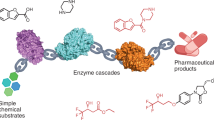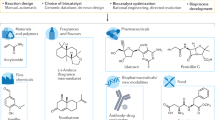Abstract
Biocatalysis is an attractive route for the synthesis of complex organic molecules, such as pharmaceuticals, due to the properties of enzymes (high specificity and high catalytic rate). Ideally, we would be able to use enzymes in continuous-flow reactors to benefit from the advantages of continuous-flow chemistry (flexibility, control, product stream purity, low capital cost and improved yields for some reactions). However, continuous-flow applications for biocatalysis face substantial technical obstacles, particularly for enzymes that require cofactors. In the work presented here we tackle two of these obstacles: the provision of cofactor and cofactor recycling in flow, and enzyme immobilization without loss of activity. This is achieved through the production of modular biocatalysts that retain and recycle their cofactors, and that allow orthogonal, site-specific covalent conjugation to a surface. This generalizable engineering approach allowed us to build a complex, multistep flow reactor that outperforms previously published systems for cofactor-dependent continuous-flow biocatalysis.
This is a preview of subscription content, access via your institution
Access options
Access Nature and 54 other Nature Portfolio journals
Get Nature+, our best-value online-access subscription
$29.99 / 30 days
cancel any time
Subscribe to this journal
Receive 12 digital issues and online access to articles
$119.00 per year
only $9.92 per issue
Buy this article
- Purchase on Springer Link
- Instant access to full article PDF
Prices may be subject to local taxes which are calculated during checkout



Similar content being viewed by others
Data availability
The data that support the plots within this paper and other findings of this study are available from the corresponding author upon reasonable request. The gene sequences for constructs reported in this work have been deposited at GenBank (https://www.ncbi.nlm.nih.gov/genbank/) under the accession numbers: MK910748, MK910749, MK910750, MK910751, MK910752, MK910753, MK910754, MK910755, MK910756, MK910757 and Q07159.
References
Wells, A. & Meyer, H.-P. Biocatalysis as a strategic green technology for the chemical industry. ChemCatChem 6, 918–920 (2014).
Turner, N. J. & O’Reilly, E. Biocatalytic retrosynthesis. Nat. Chem. Biol. 9, 285–288 (2013).
Gandomkar, S., Żądło-Dobrowolska, A. & Kroutil, W. Extending designed linear biocatalytic cascades for organic synthesis. ChemCatChem 11, 225–243 (2019).
Tamborini, L., Fernandes, P., Paradisi, F. & Molinari, F. Flow bioreactors as complementary tools for biocatalytic process intensification. Trend Biotechnol. 36, 73–88 (2017).
Zhang, Y.-H. P., Sun, J. & Ma, Y. Biomanufacturing: history and perspective. J. Ind. Microbiol. Biotechnol. 44, 773–784 (2016).
Santacoloma, P. A. & Woodley, J. M. in Cascade Biocatalysis (eds Riva, S. & Fessner, W. -D.) 231–248 (Wiley-VCH Verlag GmbH & Co. KGaA, 2014).
Weiser, D. et al. i n Biocatalysis: An Industrial Perspective (eds Gonzalo G. & de María, P) 397–430 (Royal Society of Chemistry, 2018).
Thompson, M. P., Peñafiel, I., Cosgrove, S. C. & Turner, N. J. Biocatalysis using immobilized enzymes in continuous flow for the synthesis of fine chemicals. Org. Process Res. Dev. 23, 9–18 (2019).
Dudley, Q. M., Karim, A. S. & Jewett, M. C. Cell-free metabolic engineering: biomanufacturing beyond the cell. Biotechnol. J. 10, 69–82 (2015).
López-Gallego, F., Jackson, E. & Betancor, L. Heterogeneous systems biocatalysis: the path to the fabrication of self-sufficient artificial metabolic cells. Chem.: Eur. J. 23, 17841–17849 (2017).
Akio Nakamura, H. M., Itaru, Urabe & Hirosuke, Okada Properties of glucose-dehydrogenase-poly(ethyleneglycol)-NAD conjugate as an NADH-regeneration unit in enzyme reactors. J. Ferment. Technol. 66, 267–272 (1988).
Fu, J. et al. Multi-enzyme complexes on DNA scaffolds capable of substrate channelling with an artificial swinging arm. Nat. Nanotechnol. 9, 531–536 (2014).
Krzek, M., van Beek, H. L., Permentier, H. P., Bischoff, R. & Fraaije, M. W. Covalent immobilization of a flavoprotein monooxygenase via its flavin cofactor. Enzym. Microb. Technol. 82, 138–143 (2016).
Susana, V. L., Benítez-Mateos, A. I. & Fernando, L. G. Co‐immobilized phosphorylated cofactors and enzymes as self‐sufficient heterogeneous biocatalysts for chemical processes. Angew. Chem. Int. Ed. 56, 771–775 (2017).
Keatinge-Clay, A. T. Stereocontrol within polyketide assembly lines. Nat. Prod. Rep. 33, 141–149 (2016).
Dutta, S. et al. Structure of a modular polyketide synthase. Nature 510, 512–517 (2014).
Nguyen, C. et al. Trapping the dynamic acyl carrier protein in fatty acid biosynthesis. Nature 505, 427–431 (2014).
Cronan, J. E., Zhao, X. & Jiang, Y. F. attachment and synthesis of lipoic acid in Escherichia coli. Adv. Microb. Physiol. 50, 103–146 (2005).
Davies, S. G., Fletcher, A. M., Kennedy, M. S., Roberts, P. M. & Thomson, J. E. Asymmetric synthesis of D-fagomine and its diastereoisomers. Tetrahedron 74, 7261–7271 (2018).
Castillo, J. A. et al. Fructose-6-phosphate aldolase in organic synthesis: preparation of D-fagomine, N-alkylated derivatives, and preliminary biological assays. Org. Let. 8, 6067–6070 (2006).
Hartley, C. J. et al. Sugar analog synthesis by in vitro biocatalytic cascade: a comparison of alternative enzyme complements for dihydroxyacetone phosphate production as a precursor to rare chiral sugar synthesis. PLoS ONE 12, e0184183 (2017).
Minařik, A. et al. Ligand-Directed immobilization of proteins through an esterase 2 fusion tag studied by atomic force microscopy. ChemBioChem 9, 124–130 (2008).
Huang, Y., Humenik, M. & Sprinzl, M. Esterase 2 from Alicyclobacillus acidocaldarius as a reporter and affinity tag for expression and single step purification of polypeptides. Protein Expr. Purif. 54, 94–100 (2007).
Peschke, T. et al. Self-immobilizing fusion enzymes for compartmentalized biocatalysis. ACS Catal. 7, 7866–7872 (2017).
Wang, W., Liu, M., You, C., Li, Z. & Zhang, Y.-H. P. ATP-free biosynthesis of a high-energy phosphate metabolite fructose 1,6-diphosphate by in vitro metabolic engineering. Metabol. Eng. 42, 168–174 (2017).
Schumperli, M., Pellaux, R. & Panke, S. Chemical and enzymatic routes to dihydroxyacetone phosphate. Appl. Microbiol. Biotechnol. 75, 33–45 (2007).
Britton, J., Majumdar, S. & Weiss, G. A. Continuous flow biocatalysis. Chem. Soc. Rev. 47, 5891–5918 (2018).
Contente, M. L. & Paradisi, F. Self-sustaining closed-loop multienzyme-mediated conversion of amines into alcohols in continuous reactions. Nat. Catal. 1, 452–459 (2018).
Jemli, S., Ayadi-Zouari, D., Hlima, H. B. & Bejar, S. Biocatalysts: application and engineering for industrial purposes. Crit. Rev. Biotechnol. 36, 246–258 (2016).
Modarres, H. P., Mofrad, M. R. & Sanati-Nezhad, A. Protein thermostability engineering. RSC Adv. 6, 115252–115270 (2016).
Babich, L., Hartog, A. F., van Hemert, L. J. C., Rutjes, F. P. J. T. & Wever, R. Synthesis of carbohydrates in a continuous flow reactor by immobilized phosphatase and aldolase. ChemSusChem 5, 2348–2353 (2012).
Nakamura, A., Minami, H., Urabe, I. & Okada, H. Properties of glucose-dehydrogenase-poly(ethylene glycol)-NAD conjugate as an NADH-regeneration unit in enzyme reactors. J. Ferment. Technol. 66, 267–272 (1988).
Schoevaart, R., van Rantwijk, F. & Sheldon, R. A. A four-step enzymatic cascade for the one-pot synthesis of non-natural carbohydrates from glycerol. J. Org. Chem. 65, 6940–6943 (2000).
Schoevaart, R., van Rantwijk, F. & Sheldon, R. A. Class I fructose-1,6-bisphosphate aldolases as catalysts for asymmetric aldol reactions. Tetrahedron 10, 705–711 (1999).
Babich, L. et al. Synthesis of non-natural carbohydrates from glycerol and aldehydes in a one-pot four-enzyme cascade reaction. Green. Chem. 13, 2895–2900 (2011).
Dall’Oglio, F. et al. Flow-based stereoselective reduction of ketones using an immobilized ketoreductase/glucose dehydrogenase mixed bed system. Catal. Comm. 93, 29–32 (2017).
Acknowledgements
We acknowledge the Science and Industry Endowment Fund for funding this work. We thank M. Wilding (Australian National University) and J. Oakeshott (CSIRO) for their constructive comments during the preparation of this manuscript.
Author information
Authors and Affiliations
Contributions
C.C.W., G.S., N.J.T. and C.S. obtained the funding for this work. C.J.H., C.S., C.C.W., N.J.T., J.A.S. and G.C. conceived and designed the study. C.J.H., J.A.S., C.C.W., N.G.F., Q.I.C., A.N., A.R.F., T.N. and C.N.J. performed the experiments. C.J.H., C.C.W., J.A.S., A.R.F., A.N., T.N., Q.I.C. and C.N.J. analysed the data. A.C.W. performed the computational modelling analysis. C.J.H., C.C.W., A.N., J.A.S., N.G.F., T.N. and C.S. wrote the paper.
Corresponding author
Ethics declarations
Competing interests
The authors have submitted a PCT Patent Application (WO 2017_011870_A1) based on the research results reported in this paper.
Additional information
Publisher’s note Springer Nature remains neutral with regard to jurisdictional claims in published maps and institutional affiliations.
Supplementary information
Supplementary Information
Supplementary Tables 1–2 and Supplementary Figs. 1–8
Rights and permissions
About this article
Cite this article
Hartley, C.J., Williams, C.C., Scoble, J.A. et al. Engineered enzymes that retain and regenerate their cofactors enable continuous-flow biocatalysis. Nat Catal 2, 1006–1015 (2019). https://doi.org/10.1038/s41929-019-0353-0
Received:
Accepted:
Published:
Issue Date:
DOI: https://doi.org/10.1038/s41929-019-0353-0
This article is cited by
-
Perspectives on flow biocatalysis: the engine propelling enzymatic reactions
Journal of Flow Chemistry (2024)
-
Advances in cofactor immobilization for enhanced continuous-flow biocatalysis
Journal of Flow Chemistry (2024)
-
Artificial photosynthetic cells with biotic–abiotic hybrid energy modules for customized CO2 conversion
Nature Communications (2023)
-
Multistep enzyme cascades as a route towards green and sustainable pharmaceutical syntheses
Nature Chemistry (2022)
-
Let’s stick together for continuous flow biocatalysis
Nature Catalysis (2019)



